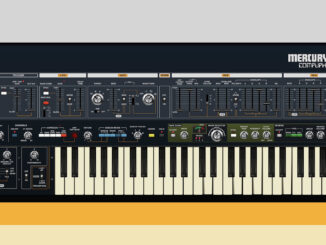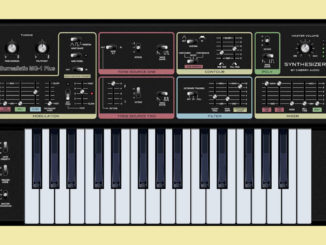Cherry Audio P-10 is a new emulation of the Sequential Circuits Prophet 5 and 10 analog polyphonic synthesizers for your DAW.
The Sequential Prophet-5 is the Synthesizer most associated with the legendary designer Dave Smith. It was also the first polyphonic analog Synthesizer with patch memory.
Many musicians used the synth in popular music and soundtracks, including John Carpenter, Vangelis, Rick Wakeman, and Pink Floyd. Since 2020, the magic of Prophet-5 and Prophet-10 has lived on as official Sequential reissues. Numerous emulations of this classic exist. The latest one is out now.
Cherry Audio unveiled the P-10 today. Interestingly, they didn’t choose the Prophet-5 but went straight for its bigger, more voice brother, the Prophet-10 – two Prophet-5 in one synth. CA kindly provided me with a license in advance.
First, an important note: I will not discuss how authentic or close P-10’s sound is compared to the original Sequential Circuits Prophet-10 Synthesizer. I don’t have the original device in the studio to compare it with the plugin.
I also never had the opportunity to spend a longer period with an original Prophet-5, Prophet-10, or even the reissues.
Cherry Audio P-10
P-10 is an emulation of the 1980 Sequential Circuits Prophet-10. Since the original and reissue Prophet-10 was or is a Prophet 5 only in two layers, the plugin can also be seen as a Cherry Audio Prophet-5 emulation.
When you open the plugin for the first time, you are greeted by an epic GUI close to the original hardware device. The main control panel, two virtual keyboards, and a sequencer section are present. I went straight to the right GUI corner and scaled the plugin smaller.
Alternatively, a function allows you to remove the keyboards from the main panel freeing up space in the DAW window – very convenient.
P-10 has two layers, but unlike the original, CA has given the synth 16 voices per layer that are freely configurable: split mode, dual-layer stack synth, etc. So, it’s a nice boost that is easier to implement in software than in analog hardware.
Oscillators & Filter
Cherry Audio has not reinvented any feature wheel in its Prophet-5 and Prophet-10 emulations. They have modeled the two original Curtis 3340-based oscillators (sawtooth, pulse, triangle) with the same features, including its juicy, legendary oscillator sync. Pulse width per oscillator and the low-frequency mode of oscillator 2 are also onboard.
In the mixer you can mix the two oscillators and add noise. Then, the signal flows into a 3320-based modeled filter with switchable lowpass and highpass option. A feature not available on the original hardware.
The filters are tweakable with classic cutoff and resonance controls as well as with adjustable keyboard tracking. Both oscillators and filters are of high quality and sounds great. The hardware sync plays lovely and is fun to work with. But others have to judge how close it is to the original.
Modulation & Poly Mod
An important component and feature of the Prophet-5 and Prophet-10 was and still is the modulation. Not necessarily the two classic ADSR envelopes (filter, amp) and multi-wave, now syncable LFO aka mono mod but the famous poly mod (poly modulator)
Poly mod is a polyphonic modulation source with two sources. You can route the filter envelope to oscillator A pitch, pulse width or filter and oscillator B to oscillator A pitch, pulse width, and filter cutoff. For example, you can archive FM between OSC B and A or FM from OSC B to filter with the poly mod.
This is where the wilder, unpredictable sound design fun begins in the original/reissue Prophet-5/10 as well as in the Cherry Audio P-10 plugin. And while the mono mod (LFO/noise) is applied to the modulation of all voices (global), the poly mod is done per voice and can differ from vovice to voice. Also a highlight of it.
Cherry Audio didn’t leave it at that and sensibly expanded it with more modulation without straying too far from the original. It comes with a new pressure mod section with support for mono and polyphonic aftertouch. Here, you can route aftertouch to various parameters.
Alongside the new pressure mode, P-10 also hosts a new AUX Mod section that extends upon the original’s pedal mod capabilities. It supports any MIDI controller and can be routed to the frequencies of the oscillators, the cutoff, the VCA and also to the mono mod so you can control the LFO/noise with it.
The addition of pressure will please many players as it allows you to play many of the classic Prophet 5 sounds very expressively. On the right GUI side, you can also find various other per-layer controls: level, control, and an EQ with low, mid and high.
Cherry Audio P-10 also ships with a per-layer drift control that subtly varies oscillator and filter parameters. This emulate the fluctuations you get in vintage analog synthesizers. To be honest, you really have to have sharp and sensitive ears to recognize these changes. They are very subtle.
Cherry Audio P-10 Second Panel: Effects
With one click you reach the second panel of the P-10. This is the home of the effects, further modulation and the arpeggiator. The effects are not found in any Prophet-5 or 10. They are only available in emulations such as the P-10. In this plugin even per layer.
You have setup for each layer an independent effects chain featuring various high-quality, best-known algoriths: distortion, 4/6/12-stage phaser, flanger/chorus, three types of delay with sync, and five types of reverb.
I don’t need to say much here. These effects are just as impressive as in the last Cherry Audio plugins. They sound high quality and can be used flexibly. A highlight here is the built-in independent modulation engine for the FX. It host a mappable per-layer LFO/noise generator and per-layer aftertouch.
Even though they are two separate sections (FX pressure, FX mono), the modulatable parameters are 99% the same. Bye Bye static effects, movement, expressive effects welcome. You can hear what effect these modulations have on the effects in the presets. Big thanks to Cherry Audio to add a global FX button on/off.
This second panel also includes a classic per-layer arpeggiator with classic patterns (up, down…), frequency control, range buttons, and a hold button. Nothing fancy new but always practical to have an arpeggiator built in.
Sequencer
Yes, I prefer the smaller GUI of the Cherry Audio P-10 Synthesizer but you can’t get around the larger version if you want to use the built-in step sequencer. It is located just to the left of the keys. It consists of four configurable individual mono- not polyphonic sequences.
Each sequence can have a custom length of up to 128 steps, gate control, loop function, and more. It’s a pretty extensive sequencer but I’m not a fan of step sequencers where you can’t see much of what you’re typing, especially in software.
That’s the case here too. The input is very “analog” and involves pressing a lot of buttons to navigate around. I would have liked a more modern approach here with visualizations of the entire sequences. A pop-up screen would certainly have helped. Nonetheless, a welcome add-on to the synth engine.
Other features worth mentioning: you can manually adjust the MIDI channel for each layer with transposing option. On top, you can import via drag-and-drop original Prophet-5 and Prophet-10 patch bank SysEx data.
Sounds
A preset browser is also built in and is available on the left side of the GUI. Cherry Audio ships the plugin with 500 presets designed by professional sound designers. It also includes the original Prophet-5 and Prophet-10 factory patches. If you have a Prophet-5/10 at home you can easily compare the two.
The quality of the included patches is high. They cover a wide range of different sounds. From classic bass, leads but also rich pads and soft plucks. Not to be missed are plenty of bi-timbral patches where they are either split or stacked on the keyboards.
I had a lot of fun with the sounds and they gave me a vintage but also modern vibe. In some places, however, there were a bit too many effects. I prefer lower amount of effects on emulation to hear better the modeled sound.
As with the Atomika, I adjusted the level of some patches because they were too loud for me. But that’s a very personal opinion. I prefer it quieter when I explore a patch for the first time.
Cherry Audio P-10 First Look Review
All in all, the Cherry Audio P-10 is a beautiful, powerful Synthesizer plugin with lots of possibilities. I can’t tell you how much of a Prophet-5 or 10 it is. It would also be wrong to say it’s the best without having a Prophet in the studio. I hope you understand my decision but I had Prophet vibes when testing it.
Unfortunately, there is no sound demo due to time constraints (Black Friday, end of year bureaucracy, etc.).
Cherry Audio P-10 is available now for $59 at the official website and retailers. It runs as a VST, VST3, AU, and AAX plugin and standalone formats on macOS (native Apple Silicon + Intel ) and Windows. A free 30-day demo is ready for download.
P-10 is also part of the recently updated Synth Stack 5 bundle, which includes all 29 Cherry Audio releases through 2024. The bundle is available for $499. The Exponents preset library by James Dyson with 100 new sounds is a separate purchase for $9.99 from the Cherry Audio webshop.
If you purchase the plugin at Plugin Boutique in November, you get a free plugin (GForce Axxess or NI Monark…) on top and support Synth Anatomy. I appreciate any help you can provide.
More information here: Cherry Audio
Available at my partner











I like Cherry Audio, but i don’t like the interfaces with the keys below, i prefer cleaner interfaces like TAL. Sounds very good though.